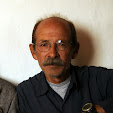April 16, 2014 – Lalish, Iraqi
Kurdistan
The smooth tan stone appears quite ordinary. Its slightly larger size than others in the open-sided courtyard area in front of the Lalish's Sheikh Adi temple draws no attention; nor does its position centered immediately in front of the arched entryway. It has been trod upon by uncounted bare Yezidian feet entering the temple throughout the centuries, if not longer, the feet that carefully step over, never on, the portal's threshhold.
Rather it is the throngs of people that draw the eyes; it is the two mirrored peacocks and other symbols chiseled into the stone above the entry that are admired; it is the prospect of visiting Sheikh Adi's tomb within that creates anticipation. Not the stone.
The smooth tan stone appears quite ordinary. Its slightly larger size than others in the open-sided courtyard area in front of the Lalish's Sheikh Adi temple draws no attention; nor does its position centered immediately in front of the arched entryway. It has been trod upon by uncounted bare Yezidian feet entering the temple throughout the centuries, if not longer, the feet that carefully step over, never on, the portal's threshhold.
Rather it is the throngs of people that draw the eyes; it is the two mirrored peacocks and other symbols chiseled into the stone above the entry that are admired; it is the prospect of visiting Sheikh Adi's tomb within that creates anticipation. Not the stone.
 |
| The Courtyard in front of Sheikh Adi Temple on a quieter day |
But this stone is not merely a stone in
a courtyard. This is the place of judgement.
As with many things Yezidian, there is a oneness of cosmology and place; a distance that is only broached by quantum leaps, if at all, in Western cultures.
As with many things Yezidian, there is a oneness of cosmology and place; a distance that is only broached by quantum leaps, if at all, in Western cultures.
This is The Place of Judgement
for Yezidis.
I am once again in Lalish, this time on the eve of the Yezidi new year, sere sal. When evening comes thousands will pack into and around this modest courtyard holding, in one fashion or another, burning cotton wicks. Excitement will mount, the trilling and whistling will rise and fall like summer cicadas as the flickering mass waits in anticipation for the Baba Sheikh and other religious men to emerge from the portal. Their bare feet too will step over the threshhold and on the stone.
I am once again in Lalish, this time on the eve of the Yezidi new year, sere sal. When evening comes thousands will pack into and around this modest courtyard holding, in one fashion or another, burning cotton wicks. Excitement will mount, the trilling and whistling will rise and fall like summer cicadas as the flickering mass waits in anticipation for the Baba Sheikh and other religious men to emerge from the portal. Their bare feet too will step over the threshhold and on the stone.
 |
| The celebration on the eve of Sere Sal |
That will be later. Now the crowds are
happily assembling in the afternoon sunlight.
“When a Yezidi dies,” Amer Sedo tells me looking down at the stone as a steady crowd flows past us on either side, “he comes here. Right here. This is where he is judged. If he has lived a good life, he goes inside,” pointing to the temple's entryway. “If he did not live a good life he goes … “ pointing abstractly in other directions. I help him find the English word hell. “... he goes to hell.”
“When a Yezidi dies,” Amer Sedo tells me looking down at the stone as a steady crowd flows past us on either side, “he comes here. Right here. This is where he is judged. If he has lived a good life, he goes inside,” pointing to the temple's entryway. “If he did not live a good life he goes … “ pointing abstractly in other directions. I help him find the English word hell. “... he goes to hell.”
 |
| Passing through the Temple's entry passage |
Amer points out some of the small
shrines (nishangah) that surround the courtyard - all within
immediate sight and most being the diminuative white-washed cones
with blacked niches where the olive oil soaked wicks are burned.
“He is judged by the six angels,” pairing names with shrines,
“And by xwede [God].” pointing to the sky. I try reconcile six
versus the seven Yezedian angels, and it is only later that I surmise
that the archangel Meleke Tawus is included with xwede.
“Here? Right here?” “Yes, right here.”
“Here? Right here?” “Yes, right here.”
 |
| Amer Sedo standing on The Place of Judgement |
I pause to think of the tempest of
other-dimensional activity passing through me as I
stand on the stone. I quickly let go of the thoughts and step off the stone.
This is The Place of Judgement.
Amer is happy to have taught me another lesson, and I to have learned.
This is The Place of Judgement.
Amer is happy to have taught me another lesson, and I to have learned.
 |
| April 16, 2014 |
I will never be able to adequately express my deepest gratitude to Amer for his years of devoted friendship and patient teaching. "Robert. Why don't you remember!?"
I














